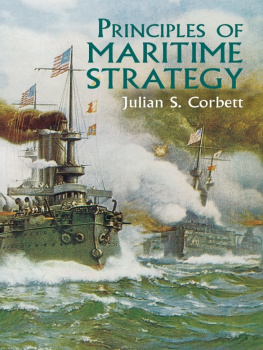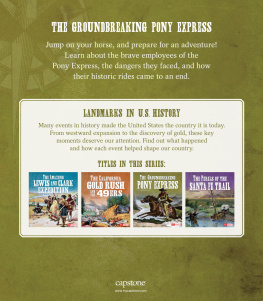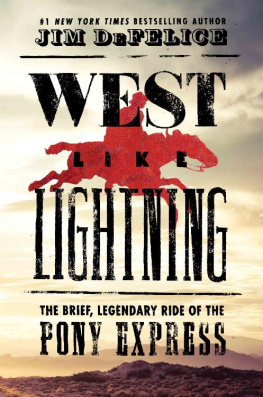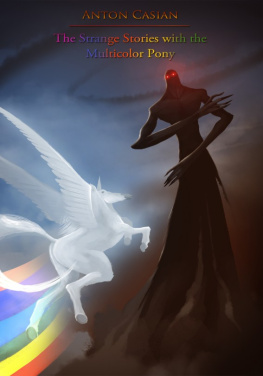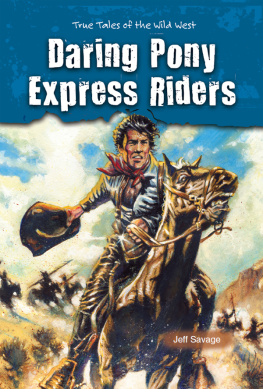
Pony Express by N. C. Wyeth.

Contents
Prologue
HOW THE STORY GOES, OR WHAT DO WE KNOW?
Part I
IN THE DAYS OF THE PONY
One
CAPITAL FELLOWSRUSSELL, MAJORS & WADDELL
Two
A WILD, UNINHABITED EXPANSE
Three
THE GREATEST ENTERPRISE OF MODERN TIMES!!
Four
PYRAMID LAKE
Five
ORPHANS PREFERRED AND THE WORST IMPS OF SATAN
Six
CAPTAIN SIR RICHARD BURTON
Seven
THE TELEGRAPH: OUR LITTLE FRIEND
THE PONY IS TO RUN NO MORE
Part II
AFTER THE PONY
Eight
MARK TWAIN... TO THE TERRITORY AHEAD
Nine
BILLY CODY'S BIG ADVENTURE
Ten
BUFFALO BILL'S WILD WEST: WHOLLY FREE
FROM SHAM AND INSINCERITY
Eleven
THE COLONEL AND HIS THRILLING AND
TRUTHFUL HISTORY
Twelve
PONY BOB HASLAM: A TRUE RIDER OF
THE PURPLE SAGE
Thirteen
MEMORY AT THE BEST IS TREACHEROUS: THE STORY OF THE STORY OF
THE PONY EXPRESS AND HOW IT GREW
Fourteen
THE BORDERLAND OF FABLE
Fifteen
BRONCHO CHARLIE MILLER,
THE LAST OF THE PONY EXPRESS RIDERS
Epilogue
THE GIRL WHO REMEMBERED JOHNNY FREY
The cautious old gentleman knit his brows tenfold closer after this explanation... At length, he observed, that all this was very well, but still he thought the story a little on the extravagantthere were one or two points on which he had his doubts.
Faith, sir, replied the storyteller, as to that matter, I don't believe one-half of it myself.
WASHINGTON IRVING, The Legend of Sleepy Hollow
Illustration Credits
TITLE PAGE: Courtesy of Archives of the American Illustrators Gallery, NYC; copyright 2000 National Museum of American Illustration, Newport, RI (www.americanillustration.org)
PROLOGUE: Commerce Bank, St. Joseph, MO
ONE: Patee House Museum, St. Joseph, MO
TWO: Library of Congress, Prints and Photographs Division (LC-USZ62-13121)
THREE: St. Joseph Museum, St. Joseph, MO
FOUR: Library of Congress, Prints and Photographs Division (LC-USZC4-2458)
FIVE: Gilcrease Museum, Tulsa, OK (0127.2333 CT)
SIX: Amon Carter Museum, Fort Worth, TX (1961.232, oil on canvas)
SEVEN: Library of Congress, Prints and Photographs Division (LC-USZ62-127508)
EIGHT: Library of Congress, Prints and Photographs Division (LC-USZ62-112728)
NINE: From collection of the author
TEN: Buffalo Bill Historical Center, Cody, WY (Image 1.69.5644)
ELEVEN: Washington State Historical Society, Tacoma, WA
TWELVE: Henry Huntington Museum, Pasadena, CA
THIRTEEN: St. Joseph Museum, St. Joseph, MO
FOURTEEN: From collection of the author
FIFTEEN: Polly Wiswall
EPILOGUE: Historic American Building Survey, Library of Congress (HABS, KANS, 101-HAN.V,1-)



Oldtimers on the porch waving to a Pony Express rider,
from a 1920 mural by Edward J. Holslag.
Prologue
HOW THE STORY GOES, OR
WHAT DO WE KNOW?
Where the years went I can't say
I just turned around and they're gone away...
KATE WOLF, ACROSS THE GREAT DIVIDE
This is how the story goes.
About dusk on the evening of April 3, 1860, the Hannibal & St. Joseph Railroad train bringing the mail from back east was more than two hours late getting into St. Joseph, Missouri, through no fault of its engineer, Addison Clark. He was a good man and true at the throttle of the train, which consisted of merely a wood-burning engine, the Missouri, its tender, and a single car. Addison Clark would set what old railroad men later claimed was a speed record, which would stand for half a century. That trip was also believed to be the first time that mail was sorted on a moving railroad car. The few passengers on board this special train, dignitaries who arrived soot-flecked and frightened in St. Joe, swore later that they feared for their lives. Ad Clark brought the Missouri down from Hannibal to St. Joea distance of 206 milesin four hours and fifty-one minutes.
Telegraphers reported that the train was going at the breathtaking speed of sixty-five miles an hour when it passed. Gangs of men standing along the line with firewood restocked the train's fuel supply in fifteen seconds. We know that much to be true.
About 7:15 that eveningdepending on whose version of the story you preferJohnny Frey (perhaps it was spelled Freye or Fry or Frye) or Billy Richardson, sometimes confused with Johnson Richardson (he was said to be a sailor, but what a sailor was doing in the heart of the country is never explained), or Alex Carlyle jumped into the saddle or leaped into the saddle or perhaps he was already in the saddle and began to gallop westward across the continent.
Writing in the October 1898 issue of Century magazine, W. F. Bailey states flatly that Henry Wallace was the first rider. Poor Henry's name is never mentioned again in the chronicles. Mr. Bailey's story was written closer to the actual event than any other account, but what of it?
That historic gallop began down in front of the Patee House, the grandest hotel west of the Mississippi River in that day, a hotel that hosted Mark Twain, Horace Greeley, Oscar Wilde, Captain Sir Richard Burton, and William Seward, who was on his way to buy Alaskaor so the story goes. Or it happened down in front of the Pike's Peak Stables, about three blocks west. No, the stables weren't there, they were someplace else. Or it happened over on the other side of town at the telegraph office on the east side of Third Streetor was it Second Street?between Felix and Edmond Streets. Or perhaps it was someplace else. Well, we know with complete certainty that it was in St. Joe. We know that much to be true.
The newspaper in St. Joseph is not much help in clearing up these matters, because the reportersome say he became excited and ran back to the office without fully gathering the factsneglected to mention who the first rider was. The style of newspapers then was very different from what it is today. But it does seem odd down these long years that a reporter sent to cover such an event would not have made mention of who was upon that horse. Long after the evening in question, a synod of St. Joseph worthies was mustered to ponder this matter, pray over it, and determine just who the first equestrian was on this momentous occasion. They advised, after lengthy deliberation and even the offering of a one-hundred-dollar reward, that they could come to no conclusion about the man aboard that first horse.




